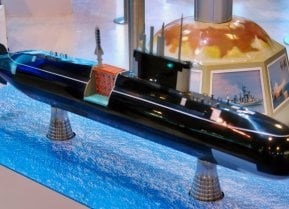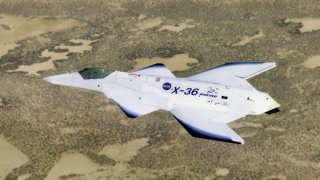X-36: Boeing Built a Tailless X-Plane That Was Historic
The X-36 had a design that was truly one of a kind and made aviation history in a number of unique ways.
Why the X-36 deserves a place in aviation history: In the collection of the National Museum of the United States Air Force at Wright-Patterson Air Force Base (AFB), located outside Dayton, Ohio, are a number of experimental aircraft that were designed as technology demonstrators.
Much like the "concept cars" of the automotive industry, the experimental aircraft in the museum's Research & Development Gallery was never really intended to be the next generation of fighters meant for war with an adversary such as Russia, but rather were designed to push the limits of aerodynamics and to test new configurations.
Some of the aircraft are truly revolutionary in design, and to the casual observer, it might even look like the designers forgot to include all of the components.
Such is the case with one of the aircraft now on display" the NASA/Boeing X-36 "Tailless Fighter Agility Research Aircraft" – which was designed by McDonnell Douglas as a subscale prototype to fly without the traditional tail section. The configuration was designed to reduce weight, drag, and radar cross-section; as well as to increase the aircraft's range, maneuverability, and survivability.
The program began in the mid-1990s as a part of a partnership between NASA and McDonnell Douglas (now Boeing) at the latter's "Phantom Works." Two unmanned X-36 aircraft were produced, and each was about a quarter of the size of a potential future fighter – however, only one of the prototype fighters was actually tested in the air. The program sought to evaluate a tailless fighter design for possible military application.
The aircraft featured an unconventional airframe layout that included forward canards near amidships with the main wing assemblies at the rear of the airframe. The X-36 was designed to fly without the traditional tail surfaces common on most aircraft, and instead, the canard forward of the wing was utilized, in addition, to split ailerons and an advanced thrust-vectoring nozzle for directional control. However, the aircraft was still unstable in both the pitch and yaw axes; therefore, an advanced, single-channel digital fly-by-wire (FBW) control system, developed with some commercially available components was required to stabilize the aircraft.
Its first flight occurred on May 17, 1997, and over the summer and early fall of that year, the prototype took to the sky an additional thirty times. By all accounts, the flight test program met or exceeded all of the project's goals, including determining the improved maneuverability as well as the pilotless design and airframe survivability. During its thirty-one safe and successful research flights over the 25-week period, the aircraft accumulated a total of 15 hours and 38 minutes of flight time, while four different versions of flight control software were used. The X-36 reached an altitude of 20,200 feet and a maximum angle of attack of 40 degrees.
In 1998, the United States Air Force Research Laboratory (AFRL) also tested the X-36 prototype with its RESTORE (Reconfigurable Control for Tailless Fighter Aircraft) software. AFRL developed this software to save a tailless fighter in case its control system was damaged or malfunctioned, and in December 1998, the X-36 made two successful RESTORE flights.
The prototype that took part in the flight tests is now on display at the National Museum of the United States Air Force, and it arrived on the same day as the Boeing Bird of Prey.
Both are on display in the Museum's Research & Development Gallery. The other prototype used in ground tests and as part of other evaluations is now displayed at the Air Force Test Flight Center Museum at Edwards AFB, California.
X-36 Specs:
Engine: Williams International F112 turbojet engine of about 700 lbs. thrust
Maximum speed: 234 mph
Highest flight: 20,200 feet
Gross weight: 1,245 lbs.
Expert Biography
Peter Suciu is a Michigan-based writer who has contributed to more than four dozen magazines, newspapers, and websites with over 3,000 published pieces over a twenty-year career in journalism. He regularly writes about military hardware, firearms history, cybersecurity, and international affairs. Peter is also a Contributing Writer for Forbes. You can follow him on Twitter: @PeterSuciu.


